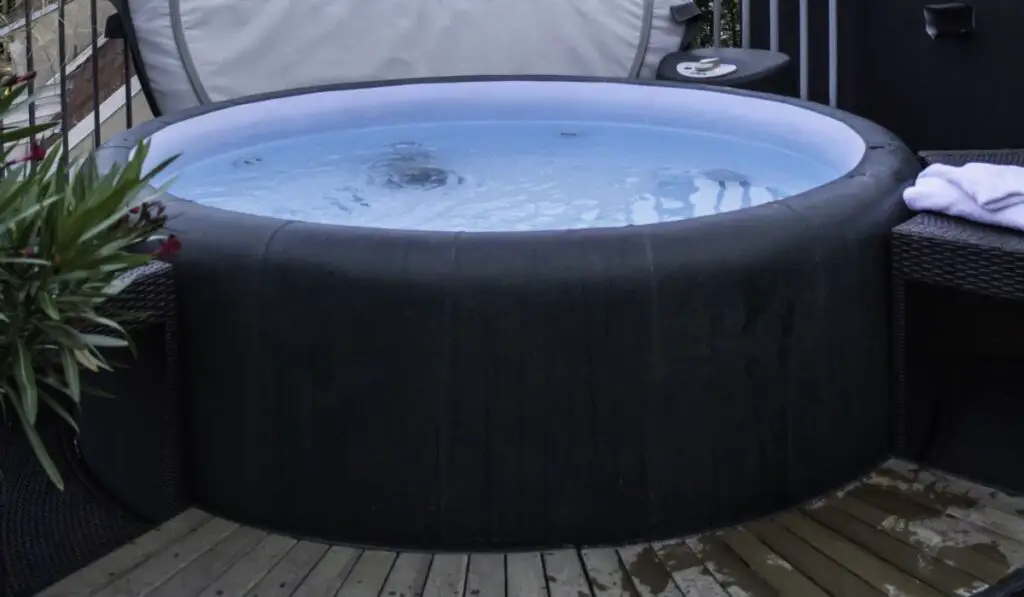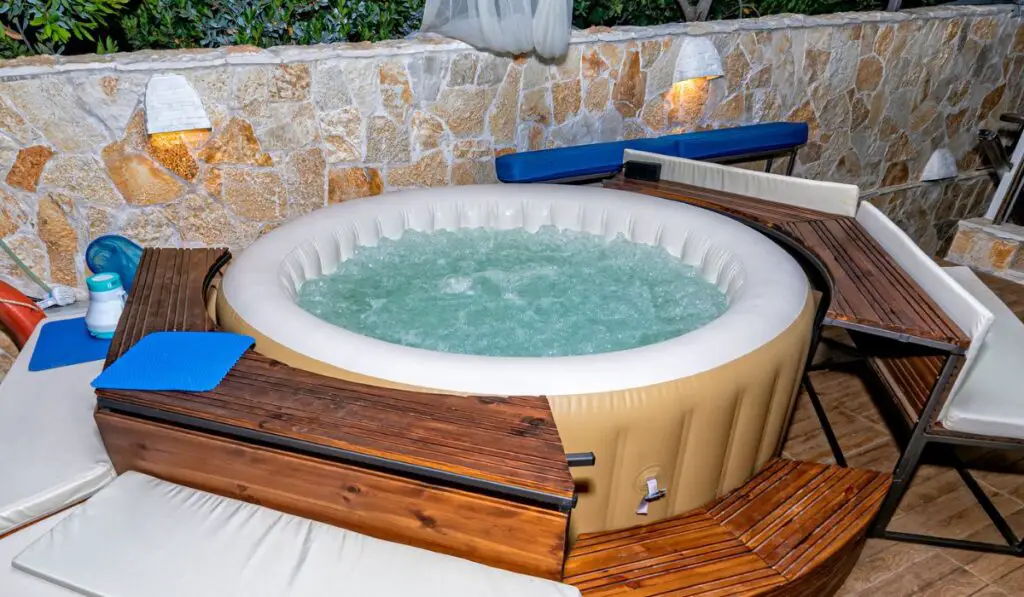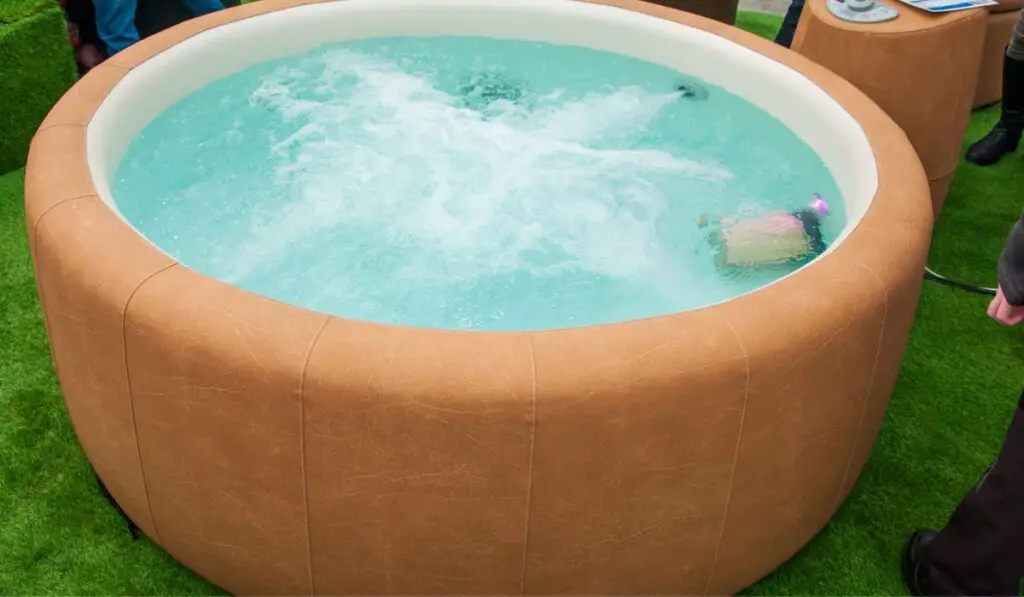An inflatable hot tub is a great option for those who want to enjoy the benefits of a hot tub without installing a permanent unit. Since the inflatable tub is made from a thick vinyl material, people often wonder how they can keep it insulated to save on energy costs and keep the water hot over time.
You can insulate your inflatable hot tub using hot tub pads, foam sheets, ground mats, or even old carpet. When choosing a material, consider how well it can prevent punctures, its durability, and comfort. Using multiple types of insulation together will help you get the most bang for your buck.
Knowing what type of material you should use to insulate your inflatable hot tub depends on how much money you want to spend and the type of surface you are installing it on. Let’s look at the different types of materials you can use to insulate your inflatable hot tub.
Can You Insulate an Inflatable Hot Tub?

Buying an inflatable hot tub is a great option for those with limited space or those who want more flexibility to move the tub around. Insulating the tub is crucial in saving yourself money on energy costs.
Another reason it’s important to insulate your inflatable hot tub is to maintain the temperature of the tub itself. This comes in handy if you are in the habit of using it often and don’t want to wait for the unit to heat up again.
Overall, insulating your inflatable hot tub can help protect your unit from the ground underneath and from the colder temperatures. Taking the time to learn what type of materials you should use to insulate your hot tub can be quite beneficial.
How Do You Insulate a Portable Spa?

While the whole point of investing in an inflatable hot tub is to have more flexibility and save on space, you will want to take many precautions to ensure the unit is working properly. One of these precautions is insulating your portable spa to protect it from the outside environment.
Even though there are many materials that you can use to protect your inflatable hot tub from the ground below and the colder temperatures, some are better than others. This is because of the materials that are used to make the insulation types.
When you are looking for the best way to insulate your portable spa, you should consider the following factors:
- Amount of insulation it provides
- Protection against punctures
- Cost
- Durability
- Comfort
Keep in mind that most types of insulation will provide some protection, but it’s worth choosing the one that will give you the best insulation possible.
Below are the best materials for insulating a portable spa:
Hot Tub Pads
These pads are created by hot tub manufacturers to put under your inflatable or fixed hot tub to add a layer of protection. They are typically cut to fit the shape of your hot tub and can be purchased in the exact size you need.
The important thing to note about hot tub pads that are precut by the manufacturer is that they are only about half an inch thick. Even though this provides a good amount of protection, it is recommended that you use this in conjunction with other insulation.
The biggest perk of this insulation is that it’s much easier to work with, as it’s cut to fit directly under your hot tub. It’s also preferable for many because it’s more comfortable to step on.
The downside is that you often have to use it in conjunction with other insulation because of its thinness. The hot tub pad that is produced by the manufacturer is also much more expensive than other types of insulation.
Hot Tub Ground Mats
These mats often come with the purchase of your inflatable hot tub and can be a great barrier against the elements of the outdoor environment. It is always recommended that you place the hot tub on a flat, smooth surface and use a ground mat (on Amazon) as a base to put it on.
While the ground mats do not offer a ton of insulation from the elements, they can reduce some of the heat transfer that can happen. Because the ground typically stays much colder, adding a layer of this mat can help to stave off the brunt of the cold.
One thing to keep in mind about hot tub ground mats is that they are typically not thick enough to provide total protection against the elements. It is recommended that you use this in conjunction with other types of insulation.
Even though most inflatable hot tubs come with this ground mat, it’s not always guaranteed that yours will. If yours does not come with one, you can always pick one up to fit your unit at your local hot tub shop or even online.
Foam Sheets
Foam sheets are a great way to add insulation and protection to the bottom of your inflatable hot tub. This is because foam is typically much thicker than other materials and can add a layer of protection like nothing else.
Foam sheets will not only protect your inflatable hot tub from the colder ground temperatures but also debris or other materials that could puncture the unit.
It’s recommended, however, that you add two to three foam sheets to the bottom of your inflatable hot tub for the best protection. This is because while the foam is thicker than other materials, it can also be pressed down with added weight on top of it.
To ensure that you get the right amount of foam sheets for your inflatable hot tub, you should measure the diameter of the unit. You can typically purchase foam sheets either online (on Amazon) or at your local hardware store.
Interlocking Foam Tiles
As stated previously, foam is a great way to insulate your hot tub to protect it from both the colder temperatures and any debris that may puncture the unit. While purchasing foam sheets may save you money, these interlocking foam tiles (on Amazon) can be much easier to use because you don’t really have to measure and cut them.
Another advantage of using these foam tiles is that they come thicker than most foam sheets, so you do not need to worry about adding several layers. They provide the protection you need to keep energy costs down and keep your unit from being punctured.
Although these foam tiles are much easier to work with and feel good under your feet, they are much more expensive than other options. If you are trying to save money, then this may not be the best option for you.
Carpet
When it comes to finding the perfect material to insulate your inflatable hot tub, many people do not think about using carpet. However, carpet can provide a great layer of insulation and can feel good under your feet.
Depending on the type of carpet you choose, it can add not only protection from the colder temperatures but also from any debris that could puncture your hot tub. Not to mention that carpet typically is much more comfortable to walk on than most other insulation types.
In some cases, depending on the type of carpet, it can be much more cost-effective to use as insulation under your inflatable hot tub. This is because you can typically find carpet remnants or even squares that can be interconnected and purchased inexpensively.
The downside to using carpet under your inflatable hot tub is that carpet that gets wet and tends to become covered in mold and mildew after a while. This means that you may have to replace the carpet from time to time, which can add to the cost of operating your unit.
What Is the Best Insulation to Put Under an Inflatable Hot Tub?
Knowing the various materials that can be used to properly insulate your inflatable hot tub can help with your decision-making process. It is also recommended that you read through various reviews to see what others have used that work best.
When considering the best type of insulation to put under your inflatable hot tub, you should factor in the purpose behind it.
Typically, your best bet is using is foam sheets, because they provide protection against outdoor temperatures and debris. When used in conjunction with a ground mat, you will get the perfect combination of protection and comfort for your unit.
With the right amount of foam sheets, your hot tub will run more efficiently because it will not have to work as hard to stay at the desired temperature. Because of this, you will save on energy costs overall as the temperature will remain steadier.
Final Thoughts on Insulating a Hot Tub

Overall, when it comes to insulating an inflatable hot tub, doing so is a great way to cut back on costs while also helping your hot tub maintain temperature. Whether you choose to insulate it with foam pads, foam tiles, or pads specifically made for hot tubs, you can’t go wrong.
Additionally, insulating your hot tub will ensure that it is free from the risk of being punctured so that it will last you and your family for years to come.
